
views
X
Research source
Make sure your topic sentences are up to par, and the rest of your writing will feel like a breeze.
Writing a Successful Topic Sentence

State your main idea clearly. Because your topic sentence is likely the first sentence of the paragraph, it needs to clearly state the subject matter of your paragraph without being wordy or difficult to understand. It must include your topic and an opinion, or your controlling idea.Make sure that the following sentences have details related to your topic sentence. Keep in mind that this is not an invitation to simply announce your topic. “Today I’m going to discuss the benefits of gardening” is not an effective topic sentence. You should be able to make your intentions clear without stating them explicitly. The topic sentence in this example states a clear direction (“health benefits of gardening”) that you can then elaborate on in your paragraph.
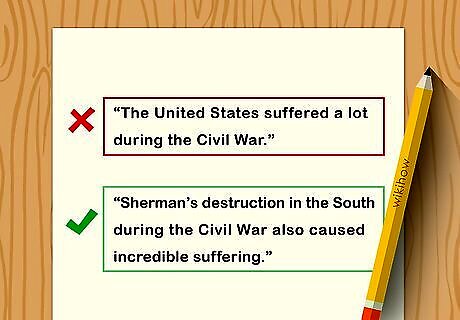
Balance the topic sentence between specifics and general ideas. The topic sentence needs to relate the paragraph to the thesis statement of the essay. However, you need to make sure that your topic sentence strikes a good balance between the broad and the narrow. Don’t write too vague or general an idea or you will never be able to discuss it in a single paragraph. This is too general: “The United States suffered a lot during the Civil War.” Don’t write too narrow of a statement. There’s nothing much to talk about then, because it’s probably a fact. This is too narrow: “Christmas trees are either cedars or firs." Instead, aim for a good balance: “Sherman’s destruction in the South during the Civil War also caused incredible suffering.” This is big enough to relate to the broader idea of an essay, but not so narrow that there’s nothing left to discuss.
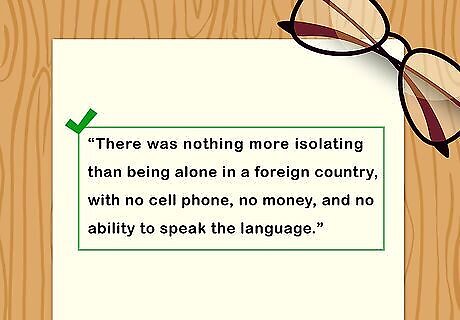
Hook your reader. One of the many important roles of a topic sentence is to draw the readers in. Bring up questions in their minds that you intend to answer. An effective way to do this is to drop them straight into the action. This is possible whether your paper is fiction or nonfiction, and can be done in a number of ways: Describe a character. This can be a physical or emotional description. Use dialogue. If there is a relevant conversation that will attract your reader’s attention, consider using part of it to start your paragraph. Portray an emotion. Use the opening sentence to portray an emotion to your reader. Use detail. While you don’t want to write a run on sentence by creating too much detail, it’s a good idea to create interest using sensory language in your topic sentence. Avoid rhetorical questions. While you want your reader to formulate questions in his or her mind, you do not want to formulate the questions yourself.

Keep it short and sweet. The topic sentence should put forward your intention without forcing your reader to hunt it down; keeping it short will help keep your intention clear. The topic sentence should act as a middle ground in your paragraph: it should be slightly more specific than your thesis, but it should not encompass the information from your entire paragraph. Keeping the sentence short will also help the flow of your paragraph.
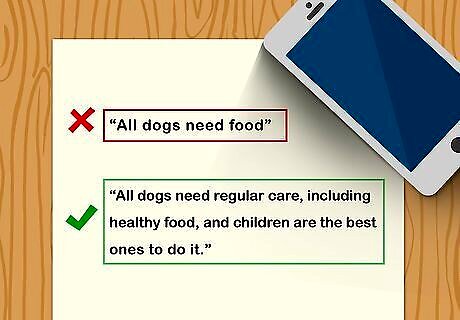
Give a reasonable opinion. The body of your paragraph is meant to prove your topic sentence. Therefore, your topic sentence should state something that you think or believe that can be supported by concrete evidence. You can choose to state an opinion in your topic sentence, but do so only if you are able to back it up in the following paragraph. Take, for example, the topic sentence “Growing herbs will further your appreciation for fresh cooking.” The phrase “further your appreciation” states something that you believe, and you can now spend the rest of the paragraph explaining why you believe what you believe. Avoid presenting only facts in your topic sentence. While facts may be interesting, they do not introduce the reader to your paragraph nor do they draw the reader in. If you wish to include a fact, also include your own input. For example, instead of writing “All dogs need food,” try “All dogs need regular care, including healthy food, and children are the best ones to do it.” Alternatively, save your facts to use as evidence in the body of your paragraph.

Use the topic sentence as a transition. Topic sentences that also work as transitions can help guide your readers through your argument, which can keep them from getting lost. Think of this sentence as a “bridge” between the main idea of the previous paragraph and the main idea of this next paragraph. Using transitional elements, such as “In addition” or “In contrast,” is a good way to show the relationship between your ideas. For example: “Although gardening has many health benefits, people still need to exercise caution when outside.” This topic sentence establishes a connection to the main idea of the previous paragraph (“health benefits of gardening”) and points to the direction of the new paragraph (“things to be cautious of”).
Planning Your Topic Sentences
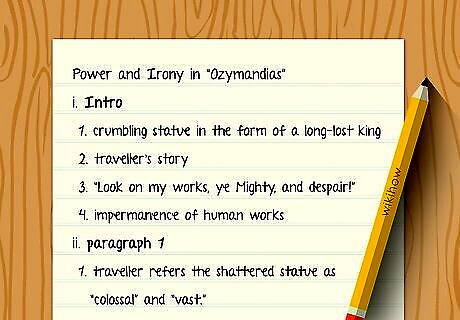
Write an essay outline. Every paragraph of your essay should have a main idea, point, or goal that you’re trying to get across. The topic sentence will identify that main idea. For you to write good topic sentences, you need to know what your paragraphs are going to be about. An outline will help you do that. You don’t have to write a formal outline using Roman numerals and the like. Even a loose, idea-based outline can help you know what you want to discuss.
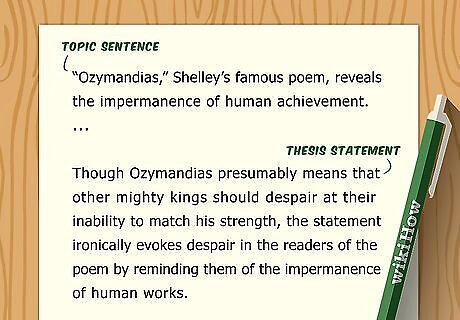
Understand the connection between thesis statements and topic sentences. A thesis statement presents the main idea, goal, or argument of your essay. It may be an analytical thesis, such as “In King Lear, William Shakespeare uses the theme of fate to critique the religious beliefs of his era.” Or, it may be a thesis that attempts to persuade the reader of something, such as “Public funding for education should be expanded.” Topic sentences are like the mini-thesis statements of each paragraph. A topic sentence, unlike a thesis statement, doesn’t have to present an argument. It can present a “preview” of what the paragraph will argue or discuss.
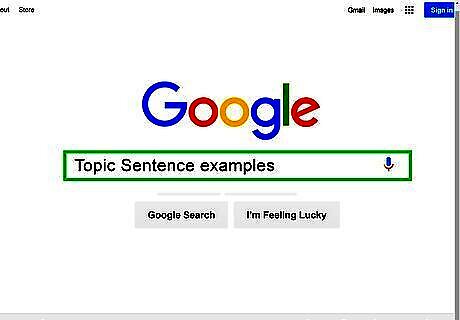
Look at some examples. If you are new to writing topic sentences, it can help to look at some examples. The Purdue OWL has several pages with sample topic sentences. UNC Chapel Hill has a helpful online handout on paragraph development that includes a “model” paragraph and explains how to develop your own, from topic sentence to conclusion. For example, a topic sentence could look like this: “In addition, increasing funding for public roads in Jackson County will improve local residents’ quality of life.” The rest of the sentences in this paragraph would relate to the main idea of public roads and how they will help benefit local residents. This is not as successful a topic sentence: “Increased funding for public roads in Jackson County has decreased traffic by 20%.” While this is probably an interesting fact for your argument, it’s too narrow for a topic sentence. The topic sentence has to direct the whole paragraph.
Avoiding Common Problems
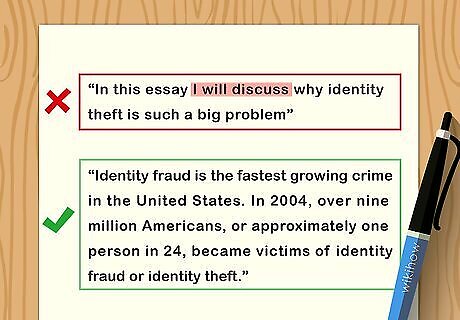
Avoid introducing yourself. Although topic sentences vary in structure and content from person to person, at least two things can be assumed about your paper: 1) that you have a title and entire paper to introduce a topic, and 2) your personal information is present somewhere on your essay. Therefore, never use statements such as “I am going to tell you…” or “My paper is about…” or “I studied [this] which is important because of [this]”. The paragraphs/essay should tell me that information without an awkward topic sentence presentation. Unless it is an opinion piece, avoid using ‘I’ in your topic sentences.

Make sure your wording is clear. Although it may sound appealing to fill up your topic sentence with big, formidable vocabulary words, if your topic sentence isn’t clear your effort will simply sound forced and confused. Your reader should be able to tell right away what your paragraph is going to be about. Don’t muddle this by using vague opinions or confusing vocabulary. Keep your sentence clear and clean.
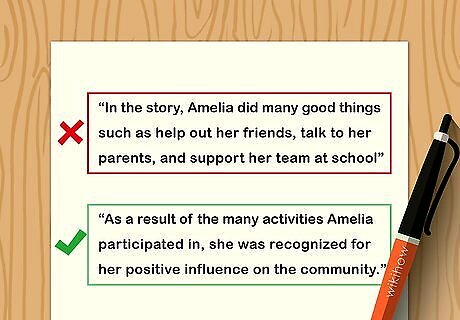
Don’t list off information. Although you want to give your readers a taste of what they can expect in your upcoming paragraph, you don’t want to show all your cards right at the beginning. Don’t make a list of what you’re going to talk about, but instead give a small taste of what is to follow in your paragraph. You don’t need to explain everything in your topic sentence, just mention it so the reader knows what to expect. Rather than stating something like “In the story, Amelia did many good things such as help out her friends, talk to her parents, and support her team at school” say something like “As a result of the many activities Amelia participated in, she was recognized for her positive influence on the community.”
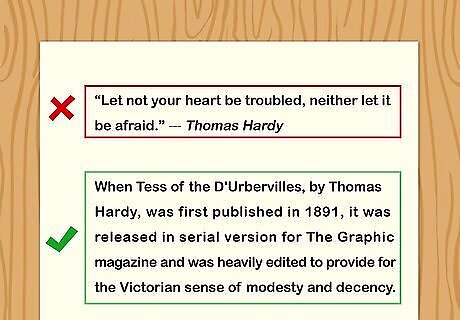
Avoid starting with a quote. You may have a fantastic quote in mind that perfectly introduces your topic. The problem is...they’re not your words. The topic sentence should introduce the paragraph and hopefully include your opinion, not someone else’s. If the quote is opinion-based, substitute it for your own opinion. If the quote is fact-based, save it and introduce it later in your paragraph.

Don’t mention something you don’t intend to examine further. If you make a statement in your topic sentence, you should be doing so because your paragraph will explain it. Whether you give facts, opinions, or both, you should be clearly analyzing them in the paragraph attached to the topic sentence. Don’t fill up your topic sentence with filler material that you don’t intend to explain further.



















Comments
0 comment